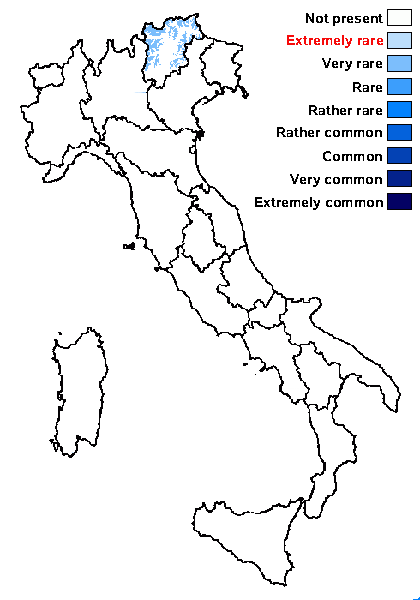Farnoldia similigena (Nyl.) Hertel
Mitt. bot. Staatss. München, 19: 443, 1983. Basionym: Lecidea similigena Nyl. - Flora, 64: 451, 1881.
Synonyms: Lecidea subrhaetica Arnold ex Lettau; Melanolecia similigena (Nyl.) Hertel; Tremolecia similigena (Nyl.) Hertel
Distribution: N - TAA (Hertel & Schuhwerk 2010).
Description: Thallus crustose, episubstratic, of strongly convex, contiguous or scattered areoles, white to yellowish white, 0.15-0.7 mm thick, forming small patches, without a distinct prothallus. Medulla white, distinctly I+ blue. Apothecia lecideine, black, somehow shiny, constricted at base, round, but often arranged in clusters and deformed by mutual compression, 0.15-0.7(-1) mm across, with a flat to convex disc, and a thick, raised, often wavy proper margin. Proper exciple very thick, black or brown-black, K+ reddish brown; epithecium blue-green to green-black, 15-20 µm high; hymenium colourless or pale green in upper part, 60-80 µm high; paraphyses coherent, simple or forked in upper part, anastomosing, 1.7-2.2 µm thick at mid-level, the apical cells to 3.5 µm wide; hypothecium pale to dark brown, much paler than exciple, 30-170 µm high. Asci 8-spored, clavate, with a I+ pale blue tholus and a central amyloid tube, approaching the Porpidia-type. Ascospores 1-celled, hyaline, narrowly ellipsoid, 10-22 x 4-6.5 µm, halonate at least when young. Photobiont chlorococcoid. Spot tests: thallus K-, C-, KC-, P-, UV-. Chemistry: without lichen substances.
Note: a rare arctic-alpine, bipolar species found on inclined to vertical faces of calciferous siliceous rocks (e.g. calcareous sandstone and schist), above or near treeline.
Growth form: Crustose
Substrata: rocks
Photobiont: green algae other than Trentepohlia
Reproductive strategy: mainly sexual
Commonnes-rarity: (info)
Alpine belt: very rare
Subalpine belt: absent
Oromediterranean belt: absent
Montane belt: absent
Submediterranean belt: absent
Padanian area: absent
Humid submediterranean belt: absent
Humid mediterranean belt: absent
Dry mediterranean belt: absent

Predictive model
Growth form: Crustose
Substrata: rocks
Photobiont: green algae other than Trentepohlia
Reproductive strategy: mainly sexual
Commonnes-rarity: (info)
Alpine belt: very rare
Subalpine belt: absent
Oromediterranean belt: absent
Montane belt: absent
Submediterranean belt: absent
Padanian area: absent
Humid submediterranean belt: absent
Humid mediterranean belt: absent
Dry mediterranean belt: absent

Predictive model
 INDEX FUNGORUM
INDEX FUNGORUM
 GBIF
GBIF
 DOLICHENS
DOLICHENS

